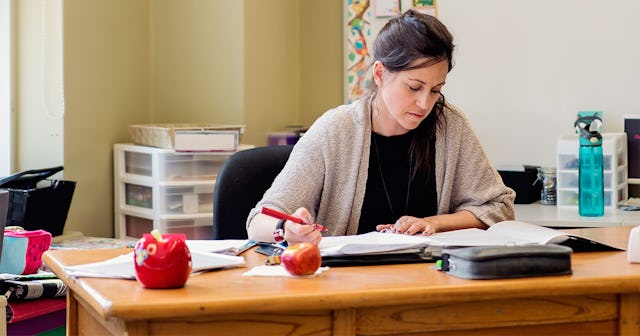There's A Solution To The Teacher Shortage ... And It's Not Great

The United States was suffering a serious teacher shortage before COVID-19 hit. The Economic Policy Institute quotes a study that states school districts “had serious difficulty finding qualified teachers for their positions” — in 2016. This would impact “students’ inability to learn,” and affect “student achievement.” It would also make teaching less attractive to graduates, perpetuating the cycle.
Then the pandemic struck, and the teacher shortage became worse than ever. The American Association of Colleges for Teacher Education, reports The New York Times, found “19 percent of undergraduate-level and 11 percent of graduate-level teaching programs saw a significant drop in enrollment this year.” In other words, students are quitting their teaching programs, or not enrolling in the first place. Even Teach for America, which sends students into low-income schools, saw a drop in enrollment this year.
Kids just don’t want to become teachers these days, exacerbating the already serious national teacher shortage.
COVID-19 Has Made the Teacher Shortage Worse: Here’s Why
The Learning Policy Institute published a report recently that found “the stress of COVID-19” was leading to, among other things, early retirements, prolonged leaves, and teacher burnout. Usually, Edsurge says, they line up replacements. But that isn’t happening. College students “aren’t entering the preservice programs.” In fact, in fall 2020, enrollment is down 4%, “especially among Black and Native American students.”
They believe the teacher shortage is due to “the cost of college and student debt.”
But RobinCrusoe on City-Data, a teacher themselves, tells a different story from May 2020. They claim the teacher shortage is due to student misbehavior during the pandemic: kids know they can’t fail because of COVID-19, and their behavior is subsequently worse. Workloads have increased. Parents want them to do more for less money. Administrators bend to both “bullying” parents and higher-ups. This has all contributed to the serious teacher shortage.
EdSurge says it more politely. Teachers, they say, are paid less for less support (presumably from administration) and “few opportunities for professional development.”
No One Wants to Teach Online… And Are Scared of In-Person
Madhourse/Getty
The New York Times says that experts think many dropped out because they’re scared to teach in-person, and they don’t want the workload of teaching virtually. Inside Higher Ed reports that The University of South Florida has actually closed its College of Education Program, and “teacher advocates” worry that part of that reason stems from COVID-19: including the pressures of online teaching and the dangers of returning to a physical classroom without adequate safety measures.
Nathan Jones, associate professor of special education at Boston University and section chair within the American Educational Research Association’s teaching and teacher education division, told Inside Higher Ed that because The University of South Florida had such a strong teaching program, he can see other programs closing because of the COVID-19 crisis.
There’s a Solution to the Teacher Shortage … But it’s Not the Best
Because of the severe teacher shortage — the tsunami of retirements that’s not being filled by bright-eyed and bushy-tailed young teachers — many states have turned to alternative certifications. South Carolina, for example, has waived the number of days education students need to spend in the classroom so students could graduate on time, reports the Charleston Post and Courier. If students would have had to spend do their required 60 full days, they would have graduated later and “exacerbated the state’s teacher shortage.” Dr. Jon Pedersen, education dean at the University of South Carolina, says, “It could have been devastating.”
As of March 10, 2021, the Charleston Gazette-Mail reports that West Virginia signed a bill allowing state superintendents to allow people to teach as long as they have a bachelor’s degree of any kind and
- Complete “pedagogical training or a pedagogical course or courses in substantive alignment with nationally recognized pedagogical standards, or approved or established by the state board [of Education]”
- Pass “the same subject matter and competency test or tests required by the state board for traditional program applicants.”
This is pretty weak sauce.
Teacher Shortage Extends To Substitutes
LeoPatrizi/Getty
But the teacher shortage isn’t just seen in full-time teachers. In Long Beach, California, EdSurge reports that the Assistant Superintendent reports that they’ve gone from a pool of 1,100 subs to 450. 75% of districts have had the same problem, and this with more teacher absences, which has led to difficulties covering classes. According to NBC, one company in Missouri encourages its employees to act as subs once every week or two, paying them the same salary. Their VP is head of the school board there, and wants to be part of the solution when the schools threatened to close over lack of substitute teachers.
Other teachers often end up covering classes instead, giving up their planning periods. Students lose valuable instruction time. And the problem is worse in majority Black and Latinx schools.
In Michigan, reports the Brookings Institute, they have resorted to billboards to recruit subs. The Madison, Ohio district has only one-third of the subs they need. They cite COVID-19 health issues as a major problem.
However you slice it, COVID-19 has made it difficult to recruit teachers. Once the pandemic ends, we may see some hope — but with more people wanting virtual school, we may find our teacher shortage worse than before. Kids don’t go to school to teach online. Alternative certification programs may lead to less qualified teachers.
We may find ourselves in worse trouble than before.
This article was originally published on